Yellampalli S. (ed.) Carbon Nanotubes - Synthesis, Characterization, Applications
Подождите немного. Документ загружается.

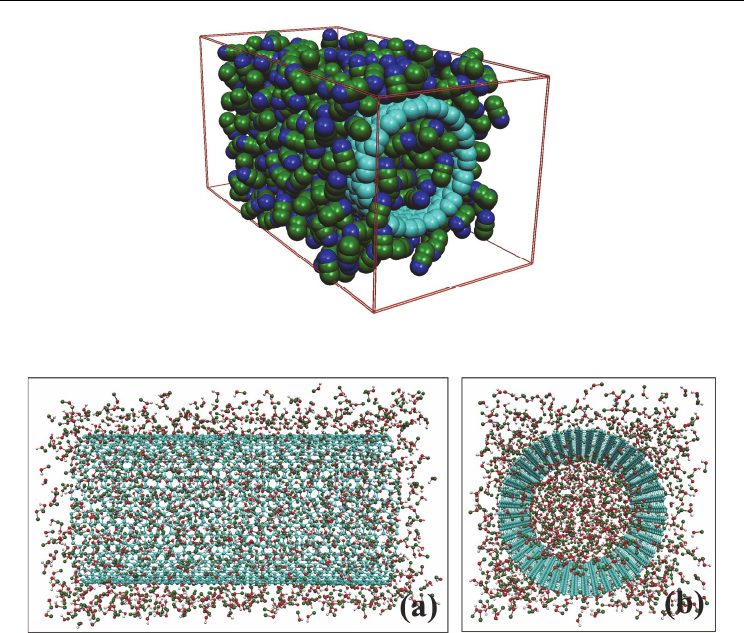
Microscopic Structure and Dynamics of Molecular Liquids and Electrolyte Solutions
Confined by Carbon Nanotubes: Molecular Dynamics Simulations
327
Fig. 1. Snapshots of MD simulation cells with AN confined inside SWCNT(15,15).
Fig. 2. Sketch of the MD cell along with SWCNT (22,22) and MeOH molecules: (a) side view,
(b) cross-sectional view.
2.2 MWCNTs – based systems
In contrast to the previous systems, the structural and dynamic properties of the solutions of
Et
4
NBF
4
of finite concentration in acetonitrile were modeled inside of MWCNTs without
any ionic or molecular species outside. The length of the greatest edge MD cell (square
parallelepiped) was chosen equal to the tube length. This, along with periodic boundary
conditions in an axial direction, allows one to create a model equivalent to infinitely long
nano-sized carbon channel of the cylindrical form filled by electrolyte solution. Such
systems have a great practical interest for development of modern double-layer super-
capacitors. For maintenance of realistic interparticle interaction potential of a solution inside
of inner volume of MWCNT, a number of walls of MWCNTs was chosen equal to three in
order to the total thickness of MWCNT was bigger than cut-off radius of van-der-Waals
interactions in the MD cell.
The composition of the modelled systems consisting of AN molecules, Et
4
N
+
and BF
4
–
ions
(Et
4
NBF
4
) and MWCNTs is presented in Table 2. Dielectric constant of the solution was
taken equal to its value for pure acetonitrile, and density at 298 K was measured in our
laboratory.

Carbon Nanotubes - Synthesis, Characterization, Applications
328
System Solvent SWCNT
SWCNT
diameter, nm
SWCNT
length, nm
Number of
molecules
Numbe
r of
ions
IA
AN
Bulk — — 216 0
IIA (26,26) 3.526 7.010 1530 0
IIIA (22,22) 2.984 6.026 887 0
IVA (19,19) 2.577 5.042 608 0
VA (15,15) 2.035 4.058 432 0
VIA (11,11) 1.493 3.074 281 0
VIIA (8,8) 1.087 2.091 216 0
IM
МеОН
Bulk — — 324 0
IIM (22,22) 2.984 6.030 428 0
IIIM (15,15) 2.035 6.030 890 0
IVM (8,8) 1.087 6.030 1530 0
VM Bulk 323 1 Li
+
VIM (22,22) 2.984 6.030 427 1 Li
+
VIIM (15,15) 2.035 6.030 889 1 Li
+
VIIIM (8,8) 1.087 6.030 1529 1 Li
+
ID
DMSO
Bulk — — 572 0
IID (22,22) 2.984 6.030 572 0
IIID (15,15) 2.035 6.030 918 0
IVD (8,8) 1.087 6.030 1000 0
Table 1. Designation and some parameters of the modelled systems based on SWCNTs with
AN, MeOH and DMSO.
System
MWCNT
MWCNT
inner
diameter, nm
Number
of AN
molecules
Number of
electrolytes
molecules
Density,
kg/m
3
Molarity,
mol/l
IE
(15,15)
(20,20)
(25,25)
1.655
133 7 Et
4
NBF
4
842.8 0.8428
IIE
(19,19)
(24,24)
(29,29)
2.197
236 12 Et
4
NBF
4
842.8 0.8428
IIIE
(22,22)
(27,27)
(32,32)
2.604
333 17 Et
4
NBF
4
842.8 0.8428
IVE – Bulk 333 17 Et
4
NBF
4
842.8 0.8428
Table 2. Some parameters of the modelled systems based on the solutions of Et
4
NBF
4
in AN
confined by MWCTNs.
As an example, the snapshot of MD simulation cell representing the system IIE is shown in
Fig. 3.
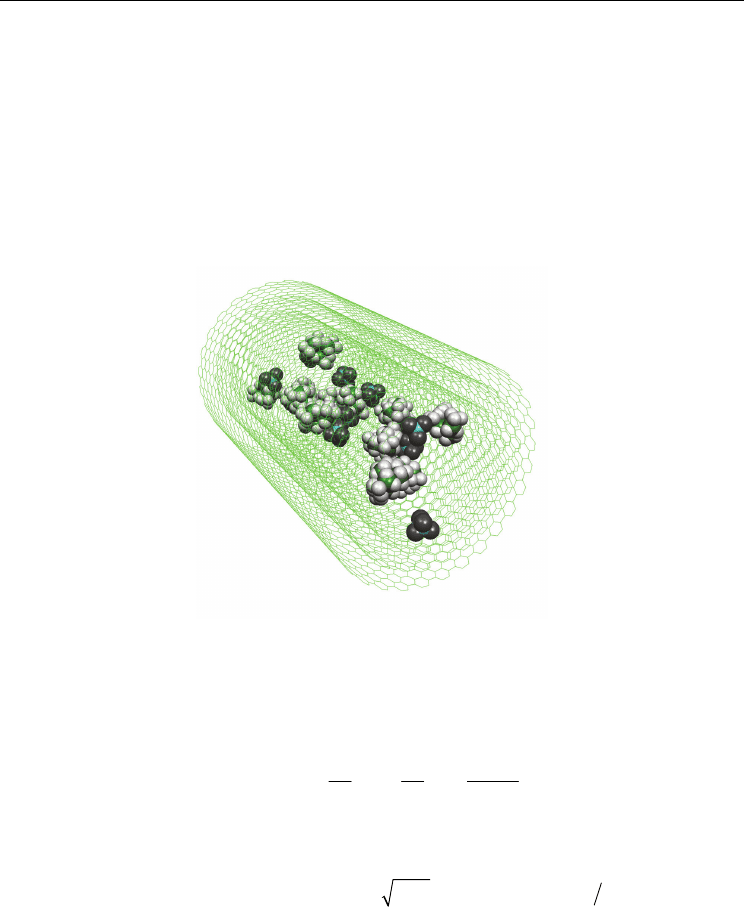
Microscopic Structure and Dynamics of Molecular Liquids and Electrolyte Solutions
Confined by Carbon Nanotubes: Molecular Dynamics Simulations
329
2.3 General approach
The MD simulations of all systems were performed with a 1 fs time-step, in the NVT
ensemble, with periodic boundary conditions in all directions at 298 K using Berendsen
thermostat with a characteristic thermostat time equal to 100 fs. System equilibrations have
been performed over 200 ps for pure solvents and 2000 ps for electrolyte solutions, and the
data were collected over at least 5 runs of 500 ps and 5000 ps for molecular liquids and
Et
4
NBF
4
–AN systems, respectively. The simulations have been carried out using the
proprietary software package MDCNT (Molecular Dynamics inside Carbon NanoTubes)
(Kalugin et al., 2006) developed by us at the Department of Inorganic Chemistry of V.N.
Karazin Kharkiv National University.
Fig. 3. Snapshots of MD simulation cell representing the system IIE. The AN molecules are
not sown.
The site-site interactions between all atom pairs in the system are given by the sum of
Lennard-Jones (LJ) 12-6 and Coulomb potentials,
12 6
2
0
()4
4
ij ij i j
ij ij
i
j
i
j
i
j
qqe
Ur
rr r
(1)
where
ij
and
ij
are the LJ parameters between sites i and j of distinct molecules, q
i
is the
partial charge on site i, and r is the site-site separation. Cross interactions were obtained
from Lorentz-Berthelot combining rules,
i
j
ii
jj
and ()2
ij ii jj
. Shifted force
potential was employed for the LJ part of the potential, whereas the reaction field method
was used to calculate the long-range Coulombic part. In this work we used the well-tested
force field models for solvent (the three-site rigid A3 (Mountain, 1997) for AN, the three-site
rigid H1 (Haughney et al. 1987) for MeOH, and the four-site rigid VG (H. Liu et al., 1995) for
DMSO) which imply the intermolecular interactions to be a sum of Coulomb and Lennard-
Jones (LJ) (12, 6) potentials, rigid bonds and fixed angles in the solvent molecules. Usage of
the force field model with rigid bond and angle values is justified by the different time

Carbon Nanotubes - Synthesis, Characterization, Applications
330
scales of intra- and intermolecular motions in the case of these liquids. The techniques of
reaction field and shifted force were applied to Coulomb and LJ (12, 6) interactions,
respectively.
LJ-parameters for Li
+
were restored from the van-der-Waals parameters (Peng et al., 1997)
according to the procedure described earlier (Kalugin et al., 2003) and already applied in our
previous works.
The force-field of the CNT carbon atoms was taken to be purely LJ (Van Gunsteren et al.,
1996). The geometrical parameters of ideal armchair CNTs were generated by the
proprietary algorithm (Kalugin et al., 2006) with the length of carbon-carbon bond equal to
0.1421 nm. The carbon atoms of the CNTs were held fixed during the MD simulations. The
CNT was assumed to be rigid with a fixed carbon-carbon bond length equal to 0.1421 nm.
Our previous test simulations have shown that the effect of carbon nanotube flexibility is
not critical for the discussed properties of the confined molecules (Chaban et al., 2010a). All
the potential parameters used in the present MD simulations are enumerated in Table 3.
Particle Geometry Site
ii
, nm
ii
, kJ/mol
i
q (e)
CNT r
CС
= 0.1421 nm С 0. 33611 0.405868 0
AN
r
CN
= 0.117 nm,
r
CMe
= 0.146 nm,
MeCN = 180°
Ме 0.36 1.588 +0.269
С 0.34 0.416 +0.129
N 0.33 0.129 -0.398
МеОН
r
ОHo
= 0.095 nm,
r
OMe
= 0.142 nm,
H
o
OMe = 108.53°
H
o
0 0 +0.431
O 0.3083 0.7312 -0.728
Me 0.3861 0.7579 +0.297
DMSO
r
SO
= 0.153 nm,
r
SMe
= 0.180 nm,
OSMe = 106.75°,
MeSMe = 97.4°
S 0.356 1.29699 +0.139
O 0.263 1.7154 -0.459
Me 0.366 0.9414 +0.160
Li
+
- Li 0.0826 26.158 +1
BF
4
–
tetrahedron:
r
BF
=0.139 nm,
r
FF
=2.27 nm
B 0 0 +0.9756
F 0.30 0.2845 -0.4939
Et
4
N
+
(D
2d
symmetry)
(Kalugin et al., 2005)
C
1
0.391992 0.48959 +0.03423
C
2
0.3875 0.73227 -0.28586
H
1
0 0 +0.08854
H
2
0 0 +0.10958
N 0 0 -0.01667
Table 3. The potential parameters for interacting sites of the AN, МеОН and DMSO
molecules, Li
+
, BF
4
-
, Et
4
N
+
ions and CNT. “Me” stands for the methyl group as united atom
(site).
2.4 Simulated properties
Keeping in mind that there should be specific structure patterns in the cylindrical confined
area, we proposed the single-atom distribution functions,
(,)Prz
, of cylindrical symmetry
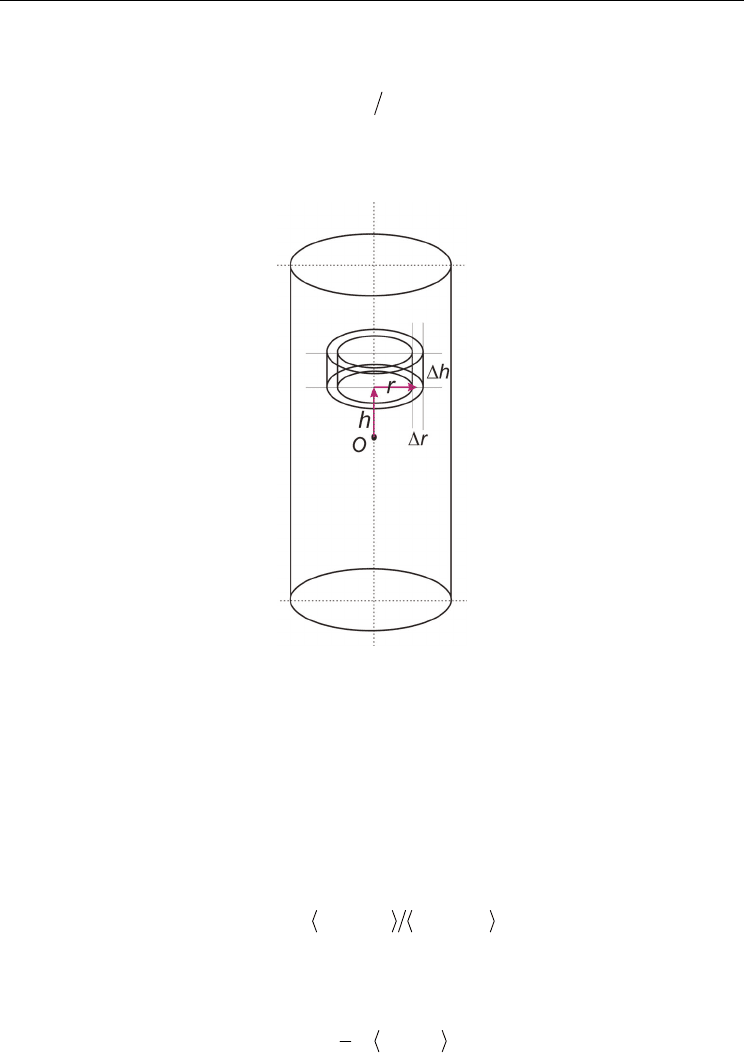
Microscopic Structure and Dynamics of Molecular Liquids and Electrolyte Solutions
Confined by Carbon Nanotubes: Molecular Dynamics Simulations
331
(Fig. 4). The cylindrical distribution functions (CDF) is defined as (Chaban et al., 2009,
Chaban & Kalugin, 2010)
inside CNT
(,) (,)Prz rz
(2)
where
(,)rz
and
inside CNT
are the local and mean atomic density of α species,
respectively, inside of the SWCNT (Fig. 4).
Fig. 4. The definition of the cylindrical distribution functions
(,)Prz
(CDF).
The local densities,
(,)rz
, were calculated by dividing the confined (by the SWCNT)
space into a number of slices in axial (
z) direction along the axis of the SWCNT (with a step
of 0.02 nm) and a number of cylindrical shells in radial (
r) direction perpendicular to axial
one (with the same step) and then taking the statistical average for the local density for each
slice or shell.
To examine the re-orientational dynamics of solvent molecules inside CNTs, we evaluate the
re-orientational autocorrelation functions (ACFs) of the unit vector
u along the molecular
dipole
μ ,
() (0) () (0) (0)Ct t
uu uu
(3)
The translational self-diffusion coefficients (SDC) were derived from velocity
autocorrelation functions via the Green-Kubo equation,
0
1
lim (0) ( )
3
t
Dtdt
vv
(4)
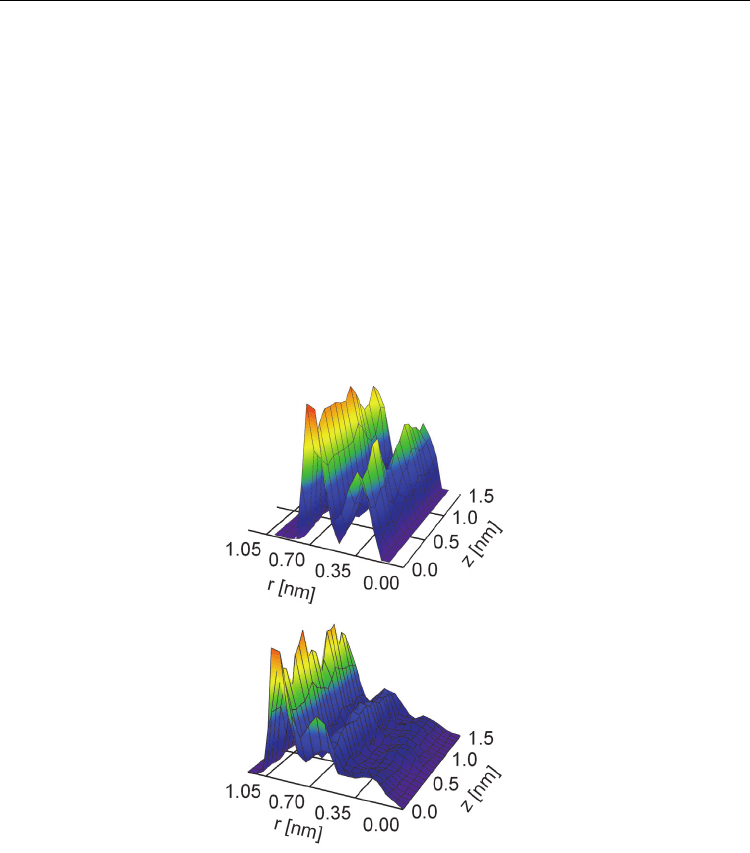
Carbon Nanotubes - Synthesis, Characterization, Applications
332
3. Results and discussion
3.1 AN based systems in SWCNTs
The solvent structure of AN inside SWCNTs was analyzed by computing the cylindrical
distribution function
(,)Prz
of the atomic density along the CNT axial (z) and radial (r)
directions. Figure 5 shows two examples of the distributions of nitrogen atomic density of
AN molecules confined inside the (15,15) and (19,19) armchair CNTs with the internal
diameters of 1.655 nm and 2.197 nm, respectively. The same oscillatory behavior of the
atomic density along the radial direction was observed for all CNTs and all AN interacting
sites, including N, C and CH
3
. The atomic density is maximal near the CNT wall, where
molecular correlations are reinforced by the space confinement. The second maximum in the
atomic density is seen about 0.35 nm after the first maximum. The height of the second
maximum is ~1.5 times smaller than the height of the first maximum. This trend was seen in
all cases. At distances larger than 0.7 nm from the CNT wall the confinement effects can be
neglected.
Fig. 5. Cylindrical distribution functions of nitrogen atomic density inside of CNTs (15,15)
(top) (19,19) (bottom). The point (0, 0) on the each graph corresponds to the geometrical
centre of the SWCNT.
One can expect that the spatial confinement of the AN molecules at distances shorter than
0.7 nm from the CNT wall should have an important impact on the solvent dynamical and
transport properties. The confinement effect is seen with both the re-orientation dynamics
and the diffusion coefficient. These types of motion are slowed down inside CNTs. The
diffusion shows a uniform dependence on the CNT diameter, while the re-orientation
exhibits strong anomalies in the CNTs whose radii are less than 0.7 nm, as elucidated below.
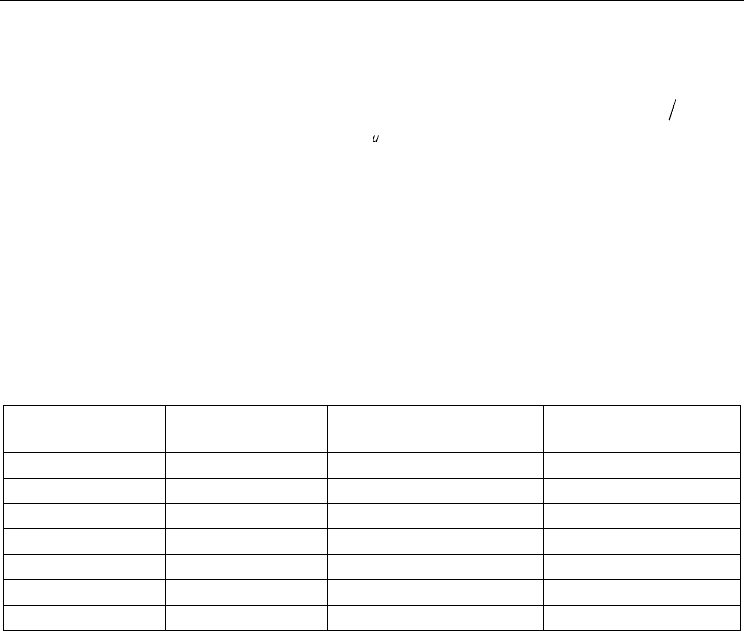
Microscopic Structure and Dynamics of Molecular Liquids and Electrolyte Solutions
Confined by Carbon Nanotubes: Molecular Dynamics Simulations
333
In order to examine the orientation dynamics of the AN molecules inside CNTs, we
evaluated the orientation autocorrelation function (ACF) of the unit vector
u along the
direction of the molecular dipole
μ , ( )Ct
. The long-time behavior of ( )Ct
extending
beyond 2 ps is well described by a single exponential decay:
ln ( ) constCt t
. The
corresponding orientation relaxation times,
, calculated using the least squares method
from the slopes of ln ( )Ct
at times between 2 and 10 ps are summarized in Table 4. The re-
orientation dynamics of AN molecules inside CNTs is drastically slower than in bulk liquid.
The orientation relaxation times significantly exceed the bulk value and increase with
decreasing CNT diameter. A uniform behavior is seen with the nanotubes from (26,26) to
(11,11), whose diameters are more than twice larger than the 0.7 nm confinement distance,
discussed above. The orientation relaxation time of AN inside the (11,11) CNT, whose
diameter is 1.1 nm, jumps to an extremely large value of 102 ps. Surprisingly, the relaxation
time for the (8,8) tube with diameter of only 0.7 nm is quite small
= 18.1 ps, and is much
closer to that of the (15,15) tube,
= 11.9 ps, than the (11,11) tube, even though the spatial
confinement effects should be strongest in the (8,8) CNT.
System
CNT inner
diameter, nm
AN self-diffusion
coefficient, D·10
9
, m
2
s
-1
AN orientation
relaxation time,
, ps
IA
–
3.240 0.004
3.9
IIA
3.526
2.52 0.05
7.9
IIIA
2.604 2.27 0.05 9.0
IVA
2.197
2.03 0.12
9.1
VA
1.655 1.69 0.12 11.9
VIA
1.113
1.09 0.22
102
VIIA
0.707 0.76 0.07 18.1
Table 4. System parameters and dynamic properties of AN molecules confined by SWCNTs.
Translational diffusion of AN inside CNTs is of great importance to a variety of
applications. The self-diffusion coefficient D was calculated by the Green-Kubo formula. In
order to avoid the open-end boundary effects, only AN molecules located more than one
molecule diameter (0.6 nm) away from the nanotube ends were used to calculate D. The
values reported in Table 2 clearly show that the diffusion coefficient of AN inside CNTs
decreases with decreasing CNT diameter. The change between bulk and the 1nm (8,8) CNT
is a factor of 4. The behavior of the translational diffusion coefficient is uniform, in contrast
to the corresponding variation in the orientation relaxation time, Table 1. This result is very
important for such practical applications as double-layer SC, which require steady solvent
diffusion inside nanoporous carbon of varying pore-diameter distributions. The spatial
confinement influences the translation motion to a lesser extent than the rotational motion,
as follows from data reported in Table 4.
Optimization and development of electrochemical devices based on nanoporous carbon
requires an analytic expression for the self-diffusion coefficient of a liquid inside the
nanopores of arbitrary diameter and length. In the absence of a general theory of fluid
diffusion in porous materials, we extended the recently proposed description of liquid
transport under steric confinement of a solid matrix (Sevriugin et al., 2003) and obtained a
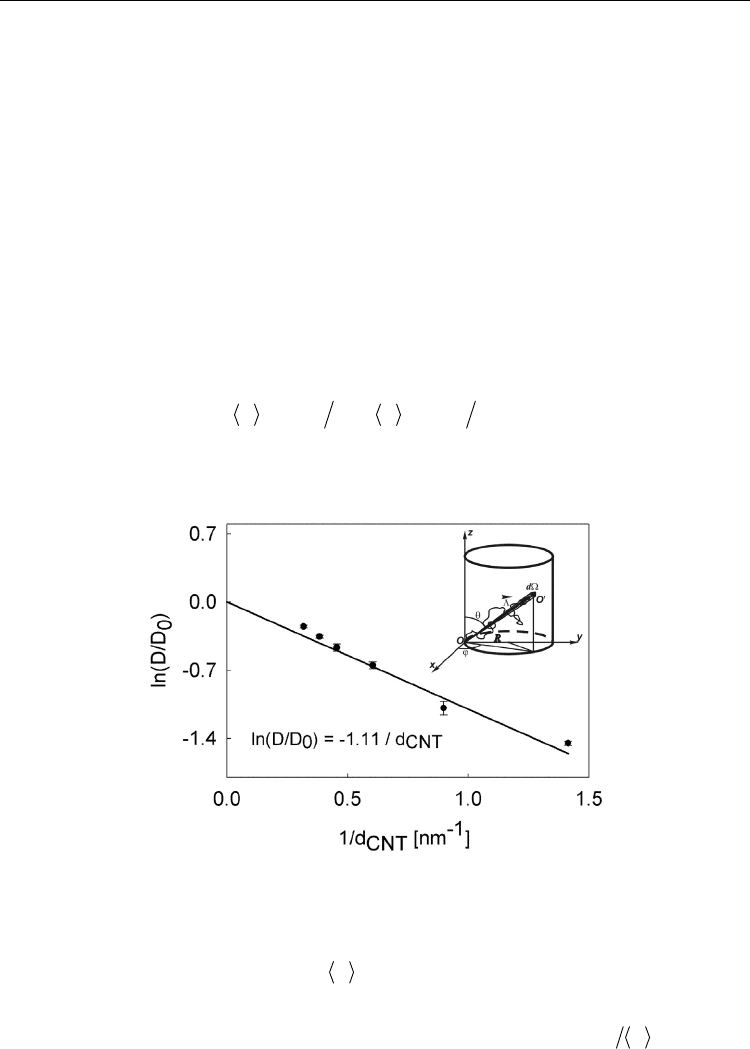
Carbon Nanotubes - Synthesis, Characterization, Applications
334
simple analytic expression for the observed trend in the diffusion coefficient (Kalugin et al.,
2008), as described below.
Reference (Sevriugin et al., 2003) shows that self-diffusion of a liquid in a heterogeneous
system is decreased relative to the pure liquid according to
0
exp( )
st
DD P (5)
where D
0
is the bulk self-diffusion coefficient, and P
st
is the probability of steric restrictions
imposed on a particle of a fluid by the surrounding matrix. The probability P
st
is determined
by the space distribution of these steric constrains or, in the simplest case, by the
confinement geometry.
Consider a liquid molecule that diffuses distance
and collides with a CNT wall, see insert
in Fig. 6. Collisions occur when the molecule is close to the CNT wall and moves towards
the wall. The thickness of the solvent layer that is sufficiently close to the wall to produce a
collision can be estimated by the mean-free path of diffusion d
m
. The directionality of the
molecular motion is accounted for by the following average
dd
dd
(6)
in which the integration is performed over the solid angle that is directed towards the CNT
wall.
Fig. 6. Relative AN self-diffusion coefficient as a function of CNT inverse diameter. Inset:
Diffusion path of a particle inside a CNT.
Geometric considerations lead to
0.64d (7)
where d is the internal diameter of the CNT. The probability that the motion of the diffusing
particle will be impeded by a collision with the wall is given by the ratio
m
d . Then, the
expression (2) for self-diffusion coefficient in the confined geometry becomes
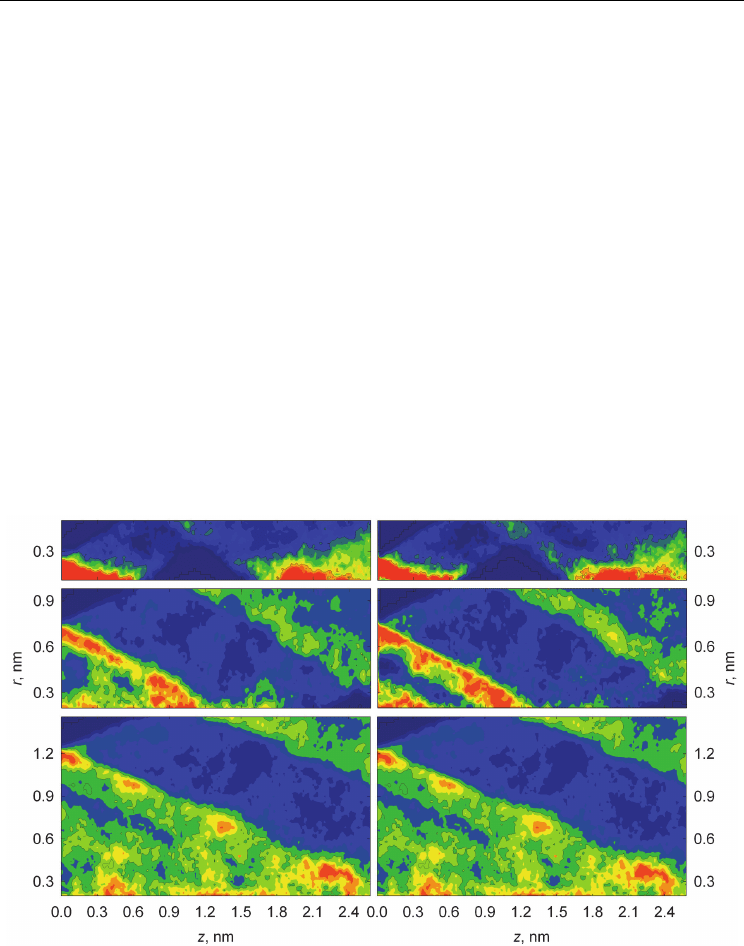
Microscopic Structure and Dynamics of Molecular Liquids and Electrolyte Solutions
Confined by Carbon Nanotubes: Molecular Dynamics Simulations
335
0
exp /0.64
m
DD d d (8)
or, explicitly inserting the value of the mean-free diffusion path for bulk AN, d
m
=0.65 nm:
0
exp 1.01 /DD d (9)
Figure 6 demonstrates good agreement between this simple theoretical expression and the
results of the MD simulation, given by the filled circles.
3.2 MeOH based systems in SWCNTs
To examine a long-range structure of a liquid methanol inside the SWCNTs, we have
calculated the cylindrical distribution function
(,)Prz
of the atomic density along the CNT
axial (z) and radial (r) directions (α - any site of MeOH or Li
+
) of cylindrical symmetry.
Contour plots of cylindrical distribution functions
(,)Prz
for the hydrogen (α =H) and
oxygen (α =O) atoms of MeOH molecules inside the SWCNT (8,8), SWCNT (15,15) and
SWCNT (22,22) are plotted in Fig. 7. Cylindrical atomic density distribution (Fig. 7) of
MeOH confined in the CNTs demonstrates the series of intertransient maxima oriented at an
angle of ~30
with respect to the CNT axes. It is interesting to note a similar character of
H
(,)Prz and
O
(,)Prz distributions, that evidently indicates the chain-like hydrogen bond
network in confined methanol. It should be also stressed, that CNT diameter influences the
Fig. 7. Contour plots of cylindrical distribution functions
(,)Prz
for the hydrogen (α=H)
(left) and oxygen (α=O) (right) atoms of MeOH molecules inside the SWCNT (8,8) (top),
SWCNT (15,15) (middle), and SWCNT (22,22) (bottom) derived from MD simulations on
systems IIM-IVM. The point (0, 0) on the each graph corresponds to the geometrical centre
of the SWCNT.
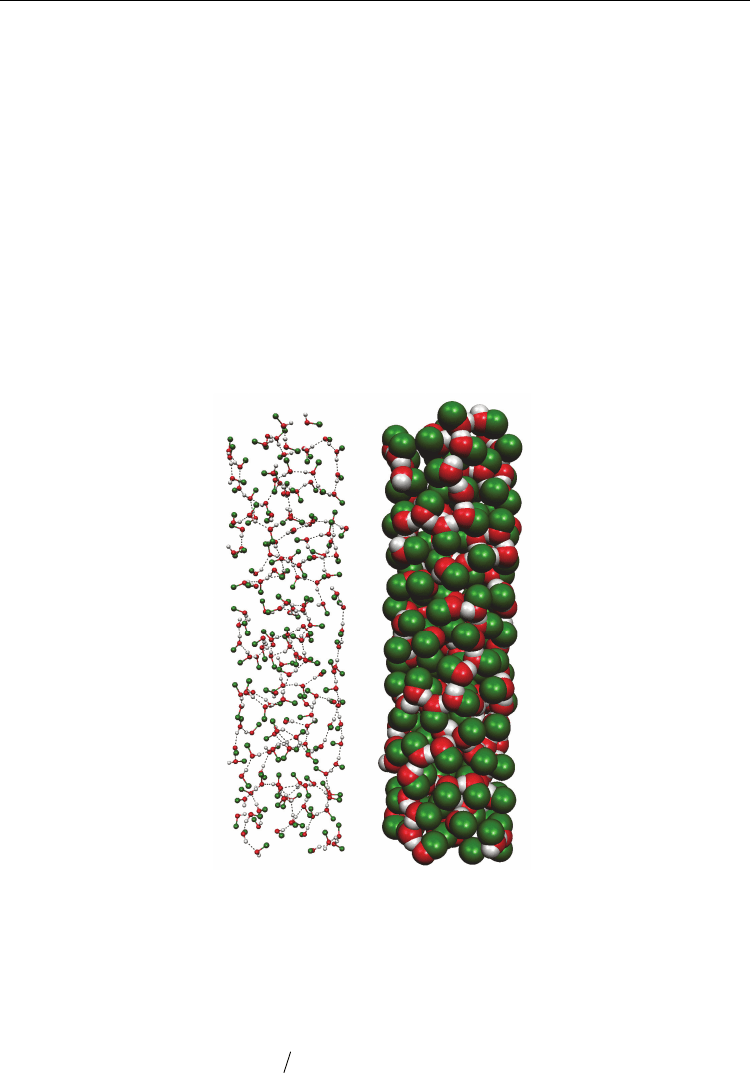
Carbon Nanotubes - Synthesis, Characterization, Applications
336
intensity of density distribution functions, but in general form of density anisotropy. These
observations allow us to make a conclusion about layered long-range structure of methanol
with helix-like distribution of H-bonds inside the CNTs.
The mentioned above conclusion about layered structure in liquid methanol inside the CNT
is completely confirmed by instantaneous configuration of the methanol molecules inside
the SWCNT (15,15) (Fig. 8). The molecular helix-like chains formed by the hydrogen-bonded
MeOH molecules inside the CNTs are clearly observed.
Bearing in mind the discussed above changes in long-range structure of liquid MeOH
driven by CNTs, it is interesting to identify the CNT influence on infinitely diluted solution
of Li
+
. In the present study, we simulated the configurations when Li
+
has already gone into
the CNT at maximum depth (3 nm far from any end of the CNT) and is initially equidistant
from the CNT walls. Cylindrical distribution function for Li
+
,
Li
(,)Prz, shows the permanent
location of the cation around its initial position (r = 0, z = 0). The mentioned deviation from
the centre point is the same inside all the investigated CNTs and does not depend on the
CNT diameter.
Fig. 8. Instantaneous configuration of the methanol molecules inside the SWCNT (15,15)
(d
CNT
=2.984 nm) at 298 К from MD simulation on system IIM in “balls and sticks” (left) and
“spacefill” (right) formats. H-bonds between MeOH molecules are indicated by dashed
lines. The helix nature of the H-bond network is clearly seen.
To examine the re-orientational dynamics of the MeOH molecules inside CNTs, we evaluate
the re-orientational autocorrelation functions (ACFs) of the unit vector u along the
molecular dipole μ, ( )Ct
. The long time (t > 4 ps) behavior of ( )Ct
is well described by
single exponent
ln ( ) constCt t
. The corresponding re-orientational relaxation times,
